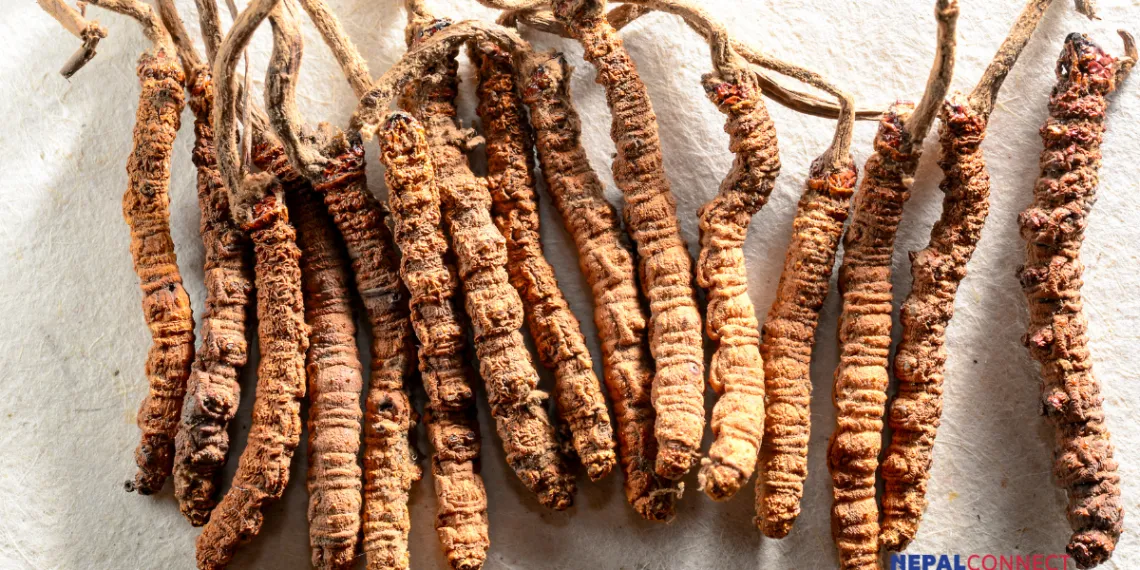Also known as caterpillar fungus, Yarsagumba is a small yet mighty herb highly valued in traditional Chinese medicine. It grows in the Himalayan grasslands of Nepal and is a main source of income for locals in the region.
The Precious ‘Caterpillar Fungus’
The scientific name Cordyceps sinensis, or Ophiocordyceps sinensis, yarsagumba, is a parasite that feeds on moth larvae. Its spores infect the larvae of soil-dwelling ghost moths (Thitarodes species), leading to the growth of a fungus that resembles a caterpillar—a unique lifecycle earning Yarsagumba its nickname, “caterpillar fungus”.
The source of Yarsagumba for generations has been the high-altitude meadows of the Himalayas, especially in districts like Dolpa, Jumla, Mugu, Kalikot, Darchula, Bajhang, and Sankhuwasabha. The collection season begins just before the monsoon rains, between April and June.
Economic Importance and Global Trade
Yarsagumba carries a lot of economic significance. Villagers in Nepal’s Himalayan regions find this lucrative trade of collecting and selling the herb indispensable.
Last year, its price per kilogram at the district level ranged from USD 22,000 to USD 30,000. The revenue from the harvesting season sustains families for several months.
The review period of 2024 shows exports of Yarsagumba to numerous countries like Australia, Austria, Cambodia, China, the Czech Republic, Greece, Hong Kong, Japan, Malaysia, Mongolia, Russia, Singapore, the United Kingdom, the United States, Vietnam, and others.
Yarsagumba carries a lot of economic significance. Villagers in Nepal's Himalayan regions find this lucrative trade of collecting and selling the herb indispensable.
Out of these, Hong Kong received the most exports, totalling 571 kilograms valued at approximately USD 2,040,501. Similarly, the departmental data points out that China was the second-largest importer, with 412 kilograms worth approximately USD 1,721,098, while Cambodia was the third, with 88 kilograms worth approximately USD 339,778 in exports.
The total exports exceeded 1,277 kilograms, with a value over USD 4.7 million, during the first eight months of the fiscal year 2024/25. It was a substantial rise from last year in both volume and value.
Climate Change and Its Impact
But the yarsagumba business is at risk now, mostly due to climate change, causing a decline in production as well as the collection of this herb. The increase in temperatures and erratic weather patterns disrupt the Himalayan ecosystem, making its collection a difficult journey.
Lately, locals from Darchula have noticed snow melting later in the year, bringing avalanches and dangers to collectors.
Nevertheless, the economic benefits of Yarsagumba continue to drive its trade. However, the market is far more complex than it appears. Informal channels often dominate, impeding the authorities’ ability to accurately track and regulate exports.
Pursottam Ojha, a former government secretary, highlights that informal exports to China significantly surpass those recorded through official channels.
A Worrisome Future
Despite the challenges, people do not refrain from harvesting. It is, after all, a high-stakes gamble. The Forest office in Mugu collected 54,000 USD in taxes on trade in the last fiscal year.
Juna Budha, a Yarsagumba harvester from Tallokot village in Bajhang district, has made the challenging trek to the highlands for the past 15 years to collect Yarsagumba. In recent times, she has seen a worrying drop in her harvest. “Eight years ago, I could collect over 500 pieces a day. Now, it’s much less,” she says, her voice heavy with concern.
Despite the challenges, people do not refrain from harvesting. It is, after all, a high-stakes gamble. The Forest Office in Mugu collected 54,000 USD in taxes on trade in the last fiscal year.
But the future of Yarsagumba and the communities that depend on it is barely hanging in a fragile balance. Environmental and economic issues alike continue to threaten both the people and the herb.
Sudipa Mahato is a junior editor with Nepal Connect.





